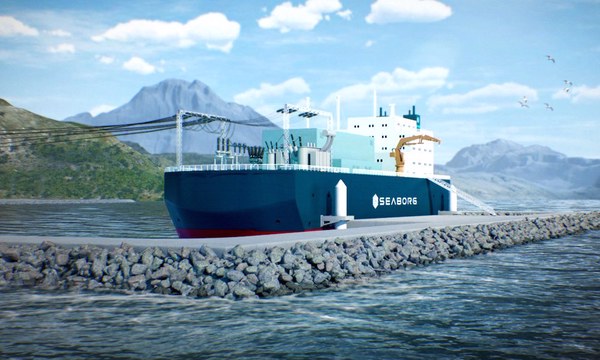INTERVIEW: Seaborg Technologies on harnessing nuclear energy to power shipping
Seaborg Technologies is building a floating nuclear power plant using a compact molten salt reactor. The company's Per Michael Jensen addresses nuclear energy's age-old stigma and why today's nuclear reactors are safer than before.

PHOTO: Concept design of Seaborg's floating nuclear power plant. Seaborg
A compact molten salt reactor (CMSR) is a nuclear reactor that uses molten salts (high-temperature liquid salts) as nuclear fuel instead of conventional solid fuels. These reactors are considered to be safer and to generate less waste than other types, making them more ideal for marine environments.
The question is, what level of safety are we talking about? The taboo surrounding nuclear energy stems from safety concerns, despite the fact that it is a carbon-free source of energy with potential to go a long way towards solving the world's renewable energy production shortage.
Per Michael Jensen, head of external affairs and communication at Seaborg Technologies, says Seaborg's CMSR will be built with fourth-generation nuclear technology that has numerous improvements over its predecessor nuclear plants in terms of security and safety.
“It’s just like driving an old aircraft or car versus a modern one. As technology advances, we discover better ways to make it safer for people," he says.
“Our technology cannot be weaponised; it cannot melt down or explode. We have taken a number of safety and security precautions to ensure that this is a completely safe and renewable power source to decarbonise the industry.”
Seaborg’s CMSR uses liquid fluoride molten salt fuel and a liquid molten hydroxide moderator that controls the reactivity. If the radioactive fuel salt is ever exposed to the atmosphere, it will simply cool down and become solid rock containing all the radioactive material within, adds Jensen.
It also has two types of reactivity control rods: regulating rods compensate for short-term reactivity changes, and safety rods extinguish nuclear chain reactions promptly. In the event of an emergency, the CMSR has a passive cooling system and an automated shutdown function.
The reactor's compact size makes it possible to scale up nuclear power for renewable fuels production. “The main issue was that nuclear plants were built one at a time, given the cost of infrastructure, space and manpower. Our technology is smaller, adaptable, and easily accessible in smaller spaces like ports and barges," says Jensen.
He says the liquid moderator does not accumulate irradiation damage and allows for a 12-year operating life without re-fuelling.
Can nuclear energy be a viable alternative to electric batteries, fuel cells or internal combustion engines on ships, given the scale advantages it offers? While Jensen accepts that we can use the same technology to power a ship, he remains sceptical that the technology will be adopted commercially for use in ships any time soon. Instead, he envisions it being widely used in ports or fuel plants to produce green versions of fuels such as ammonia, methanol, or to power electrolysers to produce green hydrogen that can be used by ships.
Jensen confirms that Seaborg is in contact with shipping companies and ports around the world, working to lay the foundations for nuclear technology to be adopted by the maritime industry in the near future.
By Konica Bhatt
Please get in touch with comments or additional info to news@engine.online





